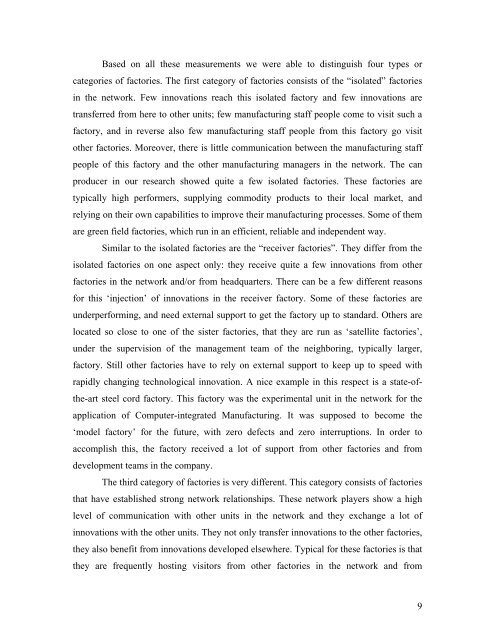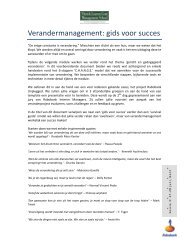Vlerick Leuven Gent Working Paper Series 2006/12 ... - Vlerick Public
Vlerick Leuven Gent Working Paper Series 2006/12 ... - Vlerick Public
Vlerick Leuven Gent Working Paper Series 2006/12 ... - Vlerick Public
You also want an ePaper? Increase the reach of your titles
YUMPU automatically turns print PDFs into web optimized ePapers that Google loves.
Based on all these measurements we were able to distinguish four types orcategories of factories. The first category of factories consists of the “isolated” factoriesin the network. Few innovations reach this isolated factory and few innovations aretransferred from here to other units; few manufacturing staff people come to visit such afactory, and in reverse also few manufacturing staff people from this factory go visitother factories. Moreover, there is little communication between the manufacturing staffpeople of this factory and the other manufacturing managers in the network. The canproducer in our research showed quite a few isolated factories. These factories aretypically high performers, supplying commodity products to their local market, andrelying on their own capabilities to improve their manufacturing processes. Some of themare green field factories, which run in an efficient, reliable and independent way.Similar to the isolated factories are the “receiver factories”. They differ from theisolated factories on one aspect only: they receive quite a few innovations from otherfactories in the network and/or from headquarters. There can be a few different reasonsfor this ‘injection’ of innovations in the receiver factory. Some of these factories areunderperforming, and need external support to get the factory up to standard. Others arelocated so close to one of the sister factories, that they are run as ‘satellite factories’,under the supervision of the management team of the neighboring, typically larger,factory. Still other factories have to rely on external support to keep up to speed withrapidly changing technological innovation. A nice example in this respect is a state-ofthe-artsteel cord factory. This factory was the experimental unit in the network for theapplication of Computer-integrated Manufacturing. It was supposed to become the‘model factory’ for the future, with zero defects and zero interruptions. In order toaccomplish this, the factory received a lot of support from other factories and fromdevelopment teams in the company.The third category of factories is very different. This category consists of factoriesthat have established strong network relationships. These network players show a highlevel of communication with other units in the network and they exchange a lot ofinnovations with the other units. They not only transfer innovations to the other factories,they also benefit from innovations developed elsewhere. Typical for these factories is thatthey are frequently hosting visitors from other factories in the network and from9










